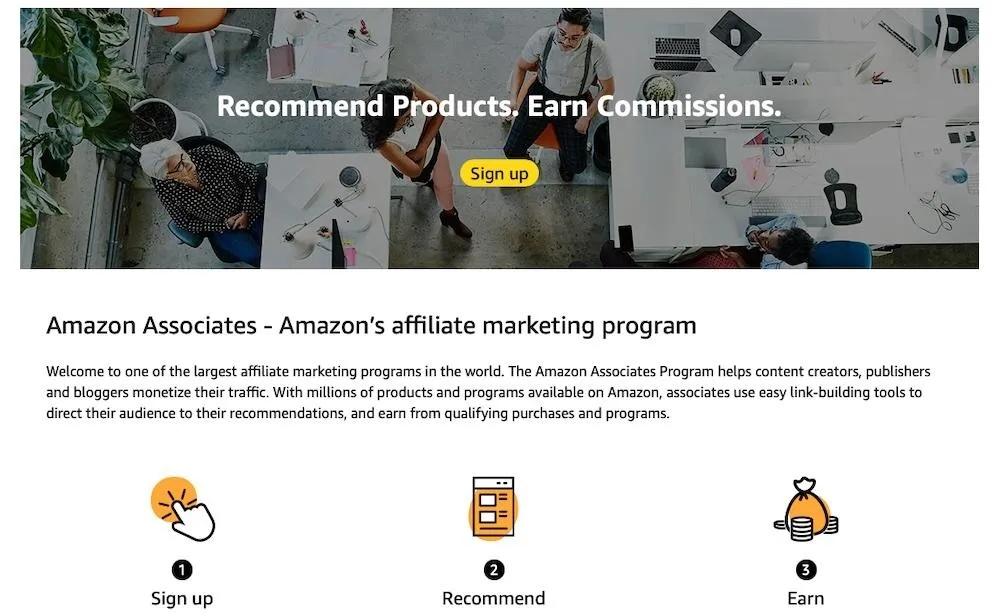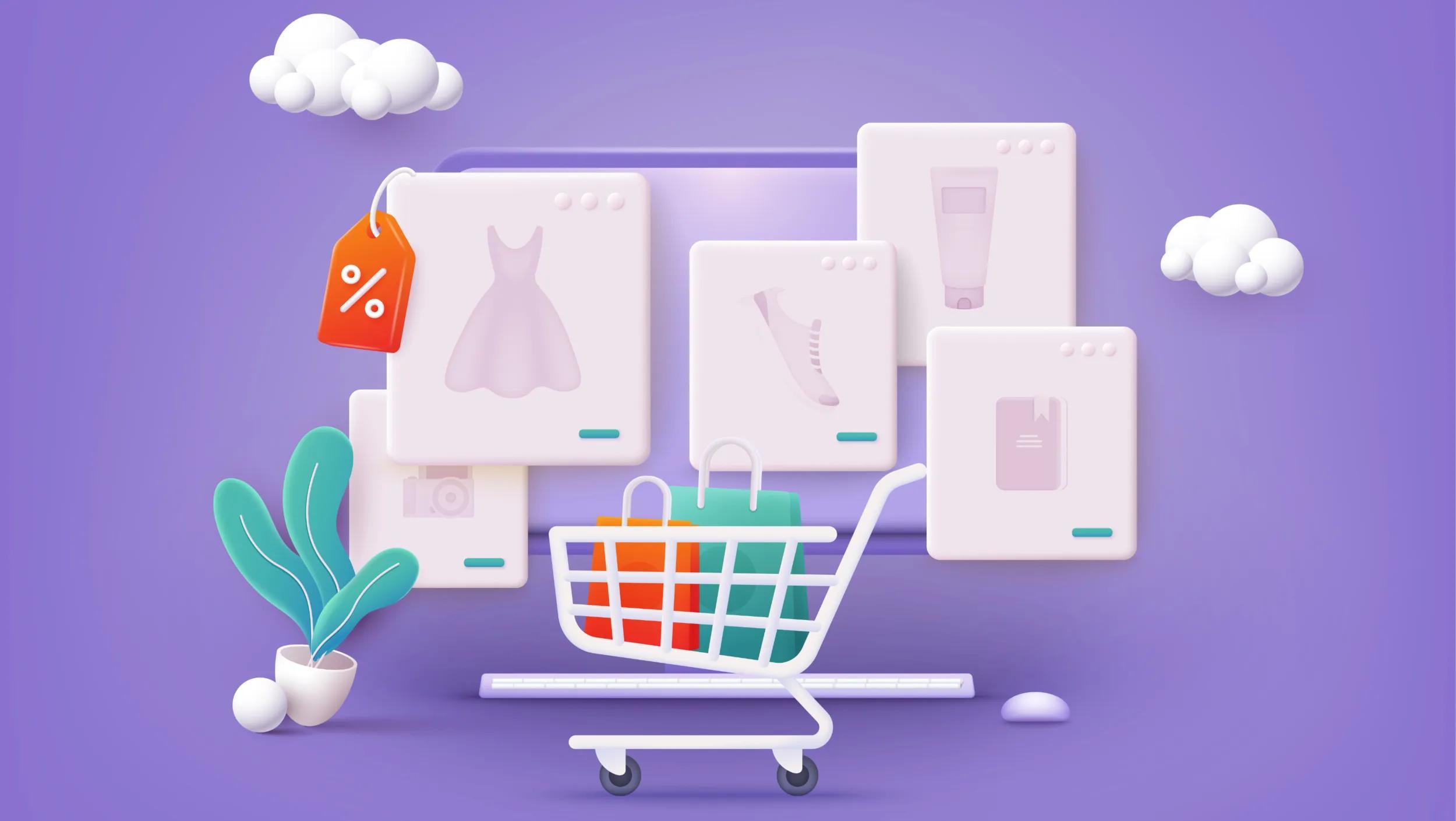As online retail sales continue to rise yearly, more and more small businesses are turning to ecommerce to boost their revenue. Interested in ecommerce for your business? We’re here to help.
This article will explain what ecommerce is, how it works, and the benefits and pitfalls that you should be aware of. Let’s take a closer look below.
What is ecommerce?
Ecommerce stands for electronic commerce and is a catch-all term describing the buying and selling of products or services on the internet.
Whether it’s a one-person shop selling handmade products or a multinational corporation managing global transactions, ecommerce helps businesses of all kinds connect with customers online.
The advantages of ecommerce are clear. With it, you can operate around the clock, access a global customer base, and lower costs by eliminating the need for physical storefronts. And shoppers benefit from convenience, a wide variety of options, and the ability to compare prices easily.
However, ecommerce comes with some challenges. There’s intense competition and maintaining a seamless customer experience while handling logistics like returns and refunds can be tricky. Businesses must also stay on top of ecommerce inventory management to avoid issues like stock-outs or overstocking.
Once a store launches, the process is straightforward. A customer selects a product or service and adds it to their cart. At checkout, the transaction is securely processed through a payment gateway, ensuring sensitive information like credit card details remains protected.
Selecting the right payment processing for online stores ensures that all goes smoothly.
Once the order is placed, the backend systems kick in, updating inventory, recording the sale, and initiating the fulfillment process.
For physical goods, this means the order is sent to a warehouse where items are picked, packed, and shipped to the customer. Digital products or services, on the other hand, might be delivered instantly through a download link or email.
Every step, from payment to delivery, is part of a tightly integrated system designed to make the process smooth and efficient for both the shopper and the business.
Ecommerce product types
Everything sold online falls into two main categories: physical products and digital products. Physical products are tangible items that need to be manufactured, stored, and shipped, while digital products include downloadable or virtual goods that can be delivered instantly.
Let’s look at these product types in more detail.
Physical products
Selling physical products is one of the most popular ecommerce models, encompassing a wide range of items that people shop for every day.
Common physical products sold online include:
- Apparel and shoes: According to Statista, clothing and shoes are among the most purchased categories online, with 43% and 33% of U.S. consumers buying these items, respectively.
- Consumer electronics: Electronics like smartphones and laptops remain a key category for ecommerce, as 55% of consumers prefer to purchase these items online rather than in a brick-and-mortar store.
- Food and beverages: Online grocery sales continue to grow, with this category taking up 26% of online shopping, per Statista.
- Beauty and personal care: Skincare, makeup, and other personal care products are popular online, with sales sitting at 24%.
- Pet products: Pet care, including food and accessories, has surged in popularity as ecommerce makes it easier for pet owners to shop from home. It currently makes up 22% of the online shopping market share.
When selling physical products online, businesses must consider key factors like inventory, shipping, and returns. Managing inventory efficiently prevents stock shortages or overstocking. Shipping logistics need to be optimized for both cost and speed to meet customer expectations, especially as fast or free delivery becomes the norm. How you handle returns matters, too, building trust and maintaining satisfaction.
Digital products
Since there’s no need for physical inventory or shipping with digital products, they’re more scalable and cost-effective than physical items.
Common digital products sold online include:
- Ebooks and online courses: The ebooks market was projected to generate revenue of $14.6 billion by 2024, with over 1.1 billion readers worldwide.
- Software and apps: Global spending on virtual goods, including software and apps, surpassed $110 billion in 2021, more than doubling since a decade ago.
- Digital media: The U.S. led digital music revenue in 2023, pulling in over $15.7 billion, highlighting the significant demand for digital media.
- Subscriptions and memberships: The subscription ecommerce market continues to grow. Globally, the market was valued at $193.6 billion in 2023 and is expected to reach $5,014.4 billion by 2032.
When selling digital products, you’ll need to make considerations that differ from physical products. For instance, digital products often require setup, troubleshooting, or guidance on use, and providing responsive, well-documented support improves the customer experience. Things like tutorials, maintaining a help desk, or having a dedicated team to address customer queries can all assist.
Another key area is the legal and licensing framework surrounding digital goods. Unlike physical products, intellectual property laws often protect digital items, and licensing terms must be explicitly stated to avoid misuse or unauthorized distribution. For example, software licenses may dictate whether the product can be used by a single user or across multiple devices.
Refund policies also require careful thought. Since these items cannot be "returned" in the traditional sense, businesses often adopt specific guidelines for refunds. Communicating these policies upfront manages customer expectations and minimizes disputes.
Types of ecommerce business models
Beyond the types of products you can sell, there are also different business models you can structure your ecommerce business around. Here are the most common:
Sales
The sales model is the most straightforward type of ecommerce. In it, businesses sell products or services directly to customers. This model is widely used across various industries, from small online stores selling handmade goods to large retailers like Amazon or Walmart. Businesses operating under this model typically generate revenue by offering goods at a markup, using discounts and pricing products to attract customers.
Subscriptions
Subscription-based ecommerce involves customers paying a recurring fee — usually monthly or yearly — for access to products or services. Examples include Netflix for digital media or meal kit delivery services like HelloFresh. This model creates predictable, recurring revenue for businesses while offering customers convenience and value.
Dropshipping
Dropshipping involves retailers selling products without holding inventory, instead fulfilling orders through third-party suppliers who ship directly to customers. Initial investment is much lower with this business model, but many dropshippers face low profit margins. Also, reliance on third-party suppliers for product quality and timely delivery is a risk.
Advertising
This model allows businesses to generate revenue by displaying ads on their ecommerce site or digital platforms. This works particularly well for content-heavy websites, blogs, or social media platforms with high traffic. While the model requires significant traffic to be profitable, it can complement other ecommerce efforts and provide an additional income stream.
Affiliate
Affiliate marketing is an ecommerce strategy where businesses earn a commission by promoting and driving sales for another company’s products or services. Affiliates use blog posts, YouTube, or social media to share affiliate links, earning a percentage of each sale made through their referrals. Programs like the Amazon Affiliate program allow businesses or individuals to monetize their content by directing users to Amazon products. This model has low startup costs, but does require consistent effort to build a large and engaged audience.

B2B (Business-to-Business
The B2B ecommerce model involves transactions between businesses, like wholesalers selling bulk products to retailers or software companies providing enterprise solutions. Platforms like Alibaba or software providers like Salesforce are good examples of this. The B2B model involves larger transactions, long-term relationships, and customized solutions,
Where ecommerce is taking place in 2025
Ecommerce continues to grow rapidly, creating incredible opportunities for entrepreneurs. In the U.S., ecommerce sales reached $291.6 billion in Q2 2024. And globally, ecommerce sales are projected to surpass $8 trillion by 2027.
There are now more ways than ever to engage in e-commerce:
Online stores
Platforms like GoDaddy Online Store help you develop customized ecommerce stores and give you full control over branding, product presentation, and customer engagement. These stores are ideal for businesses that aim to create a unique identity and build direct relationships with their customers.
Merchant centers
Marketplaces like Amazon and Etsy provide sellers with access to massive audiences and established systems. It is sometimes easier to reach customers through these merchant centers but they’re overloaded with competition, carry platform fees that eat into profits, and harbor strict policies that you’ll need to abide by.
Local marketplaces
Tools like Facebook Marketplace make it so you can sell directly to local customers. This works well for those who want to focus on community-based sales or if you sell products that are best suited for in-person delivery — like selling plant cuttings or vintage furniture.
Social commerce
Platforms like TikTok have transformed social selling through shoppable videos and influencer partnerships. Social commerce combines engaging content with ecommerce, making it easy for people to purchase directly within the platform. Brands in the fashion, beauty, or lifestyle arena can especially benefit from social platforms, as they offer a way to reach younger, trend-focused audiences.
Current trends show that ecommerce is growing most quickly in mobile commerce, social commerce, and personalized shopping experiences. Mobile commerce, in particular, has surged, with 60% of online orders now originating from mobile devices.
Social platforms like Instagram, TikTok, and Pinterest are integrating more shopping features, too, letting people discover, browse, and purchase all without leaving the apps.
Weighing which trends to follow is always difficult. But often, you can embrace more than one at a time. For instance, instead of comparing affiliate vs. influencer marketing, you can leverage both.
And to stand out in this crowded space, you’ll need to stay ahead of the curve of the latest trends as they emerge. In 2025, that means ensuring your store is mobile-optimized, socially tapped-in, and delivering personalized customer experiences through recommendations.
What it takes to succeed in ecommerce in 2025
As ecommerce continues to grow, so does the competition, making it more challenging for businesses to stand out. In 2025, success will require shop owners to adopt innovative strategies, refine operations, and deliver fantastic results.
That all sounds lofty, but it is extremely doable — especially if you build a solid foundation from the start. Whether it's choosing the right ecommerce platform, investing in personalization, or focusing on critical ecommerce KPIs, staying ahead will demand agility and a commitment to continuous improvement. Now is the time to make money with ecommerce, so let’s next focus on the challenges online stores are likely to face in 2025 and how to overcome them.
Competing against Amazon
In 2025, one of the biggest challenges for ecommerce businesses will be competing with Amazon, which continues to dominate. It has a gigantic inventory, fast shipping, and low prices. For smaller businesses, trying to match Amazon’s scale is nearly impossible, but there are ways to carve out a space for yourself. The key lies in creating niche markets and delivering personalized experiences that Amazon can’t replicate.
Focusing on a niche means you can focus on specific customer needs.
Unlike Amazon’s broad approach, niche brands build deeper connections with their customers and provide specialized products or services.
Exceptional customer service and transparent brand storytelling are other critical tools for competing against Amazon. By learning how to humanize your brand, you can build trust and loyalty among customers. Sharing behind-the-scenes content, showcasing founder stories, or engaging directly with customers on social media all create a community around the brand. The Women Working in Technology website offers a good example of this:

The site includes detailed background information on the founders and team with integrated video.
Offering exclusive products can make a difference, too. Whether it’s handmade goods, limited-edition collections, or custom services, exclusivity adds value and drives customer interest.
Website security
As ecommerce continues to grow, so do concerns about cybersecurity. Protecting customer data and building trust continue to be critical for ecommerce success. With increasing risks of fraud, data breaches, and phishing attacks, customers are becoming more cautious about where they shop online.
To address this, ecommerce store owners must prioritize security measures like SSL certificates, fraud detection tools, and regular vulnerability scans.
An SSL certificate, for example, protects customer data and reassures visitors by displaying a secure padlock icon in the browser. Fraud detection systems and monitoring tools can help prevent unauthorized transactions, safeguarding both the business and its customers.
For busy ecommerce entrepreneurs, choosing a secure ecommerce platform like GoDaddy simplifies these challenges. Platforms like GoDaddy are committed to maintaining the highest security standards, allowing store owners to focus on their business rather than technical vulnerabilities.
Maintaining customer loyalty
With rising competition and endless options, retaining customer loyalty in 2025 will be harder than ever. Customers get more selective by the day, often opting for the best deal or the most convenient option. Add in subscription fatigue — a growing reluctance to commit to recurring payments — and it’s increasingly difficult to retain customers.
To counteract these trends, you need to deliver consistent value to customers. Implementing loyalty programs that reward repeat purchases with discounts, early access to products, or freebies can help keep customers engaged. Any of these ecommerce customer loyalty ideas can be a powerful retention tool.
Communication also matters for building loyalty. Regular updates, engaging email campaigns, and personalized recommendations remind customers why they chose your brand in the first place. Exclusive offers tailored to individual preferences further strengthen the relationship. Finally, leveraging feedback to refine your offerings and creating advocates through customer advocate programs ensures customers remain loyal and spread positive word-of-mouth.
Invest in ways for people to find you
Visibility will be a major challenge in 2025 as well. Ecommerce is crowded, so even the most beautifully designed store won’t thrive if potential customers can’t find it. You’ll need to invest in strategies that make your store discoverable across multiple channels, from search engines to social media platforms.
Search engine optimization (SEO) remains one of the most effective ways to boost visibility. A strong ecommerce SEO strategy means your store ranks higher in search results and drives organic traffic. Paid advertising, like Google Shopping campaigns, can complement organic efforts and target highly specific audiences.

Social media platforms also play a key role in discoverability. TikTok and Instagram drive traffic and engage real people through visual storytelling and shoppable content. Pairing these content marketing efforts with a strong email marketing strategy featuring newsletters, exclusive offers, and product launches and your audience will stay connected and engaged.
Standing out from the crowd
In a saturated market, having a unique value proposition (UVP) is a must. Customers need a clear reason to choose your ecommerce store over the thousands of others available. A strong UVP paired with memorable branding can make all the difference in attracting and retaining customers. But this goes beyond using a consistent color scheme or choosing a recognizable ecommerce domain name.
Incorporating user-generated content (UGC) is one way to stand out, as it provides authentic social proof. Encouraging customers to share photos, reviews, or testimonials builds trust and strengthens your brand’s credibility. Teaming up with influencers helps, too. For instance, streetwear brand Urban Monkey ran a hashtag campaign that resulted in a 200% increase in social media mentions and a 15% increase in sales.

Storytelling also plays a role in differentiation. Sharing your brand’s mission, values, and origin story helps customers feel emotionally connected to your business. And experimenting with innovative technologies like augmented reality (AR) or live shopping events can capture attention and create unique customer experiences.
Your online store options when launching an ecommerce business
If you’re ready to launch an ecommerce business, having the right resources can make all the difference. The GoDaddy guide to ecommerce is a comprehensive, free resource that provides a complete walkthrough for how to start an online store. From selecting a domain name and designing your website to managing inventory and processing payments, this guide covers every aspect of starting and running an online business.
GoDaddy Online Store

GoDaddy Online Store is an intuitive, all-in-one platform for launching an online store. Designed specifically for small businesses and startups, it simplifies the site-building process thanks to customizable templates, secure payment options, and integrated marketing tools.
Getting started with GoDaddy is straightforward. Begin by selecting a design template that matches your industry then customize it with branding, images, and content. Key features like built-in payment gateways, mobile responsiveness, and SEO tools all ensure your shop is ready to reach customers.
It also includes inventory management and analytics tools, making it easy to monitor sales and optimize your business operations.
GoDaddy Online Store is particularly well-suited for those just getting started or running small to medium-sized businesses. Add in GoDaddy’s 24/7 customer support and a wide range of resources, and you can count on expert guidance at every step.
WooCommerce + WordPress

WooCommerce integrated with WordPress is an excellent solution for those who want to build a powerful ecommerce website with content creation capabilities. WooCommerce is a free, open-source plugin that transforms WordPress sites into fully functional online stores.
Setting up WooCommerce with WordPress requires slightly more technical know-how than other platforms but in exchange does offer a great deal of flexibility and customization, although Managed WordPress Hosting from GoDaddy can simplify some of the process.
With access to thousands of themes, plugins, and extensions, you can design a site that meets your specifications. WooCommerce supports numerous payment gateways, shipping options, and integrations with email marketing platforms as well.
This setup works well for those looking to establish themselves as experts within a niche while selling products. For instance, a fitness coach could use WordPress to blog about wellness tips while selling workout plans, ebooks, and merchandise through WooCommerce.
Selling on Amazon or Etsy

If you’re looking to tap into an existing customer base, selling on platforms like Amazon or Etsy is a great option. These marketplaces have expansive reach, so you can showcase your products to millions of potential buyers. Amazon is ideal for a wide range of products, from electronics to household goods, while Etsy focuses on handmade, vintage, or niche items.
Setting up an Amazon or Etsy store is relatively straightforward. On Amazon, sellers create an account, list their products, and use tools like Amazon FBA (Fulfilled by Amazon) to manage inventory and shipping.
Etsy, on the other hand, emphasizes personalized branding and community engagement, making it a better fit for artisans and small-batch creators. Both platforms offer detailed analytics to help sellers refine their listings and grow their businesses.
These marketplaces are suitable for those looking to start selling quickly without building their own ecommerce website. However, success on these platforms requires competitive pricing, excellent product descriptions, and high-quality images.
Ready to launch your ecommerce business?
Ecommerce levels the playing field, allowing entrepreneurs to turn passion projects into thriving businesses. With dedication and smart strategies, your online store can flourish in 2025 and beyond. Don't let the competition intimidate you - carve out your niche, tell your story, and deliver fantastic products.
The possibilities in ecommerce are endless. And by putting the customer first, you'll be well on your way to ecommerce success, even in an increasingly competitive landscape. The time is now to start that online business you've been dreaming about. With the right vision and the tips outlined here, your ecommerce store can win customers and thrive in the years ahead.
Helpful resources:






